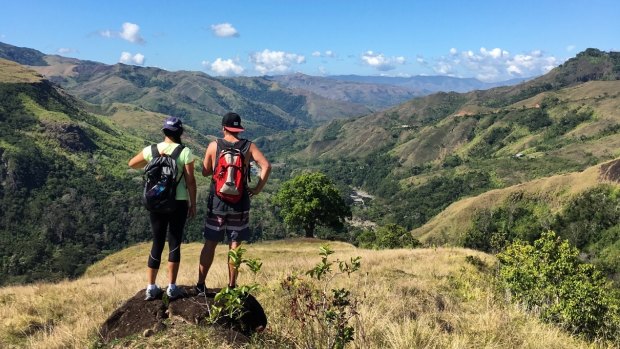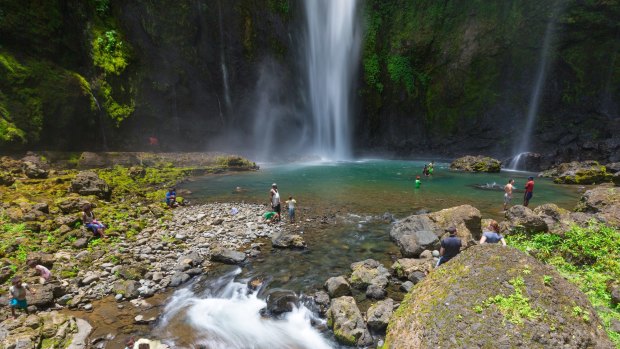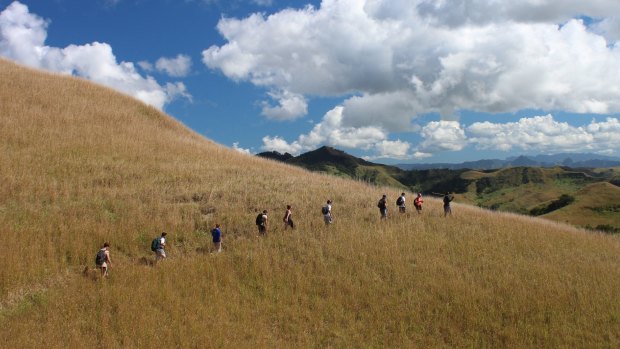This was published 4 years ago
Viti Levu hiking: Fiji's tallest mountain and a trek on the wild side
By Andrew Bain

Talanoa Treks works in partnership with the villages to run the hikes, taking us across the highlands' unmarked tracks. Credit: Talanoa Treks
It's a climb that kicks harder than kava. Approaching the summit of Fiji's highest mountain, Mount Tomaniivi, deep inside cloud forest, the going is steep, muddy and convoluted.
There are boulders to scramble over, and tree roots splay through the air above the track. At times the only way through is to walk atop the roots as though they're some kind of elevated boardwalk.
It's a climb that feels so remote as to be almost exploratory, except that our guide, Toto, is still clipping ahead easily in his gumboots, a machete dangling casually from one hand.

It's a more intimate and immersive look at traditional Fiji than perhaps any other tourist experience offers.Credit: Alex Rengel
"This track is easy now," he says with a smile as we struggle on behind him. "Before Cyclone Winston, it was very difficult. There were so many trees here then."
Crowning Fiji's main island, Viti Levu, 1324-metre Mount Tomaniivi is little taller than the Blue Mountains or Hobart's Mount Wellington, but its slick slopes will make this the shortest yet toughest of the three days I spend hiking across Fiji's highlands with Talanoa Treks, the only company running multi-day hikes in Fiji.
It's a trip during which the walking is a part of the pleasure, the thread that connects a string of remote villages where tradition and culture still dictate existence. We will eat as the villagers eat, sleep on the floor of community halls, and be welcomed each night by kava ceremonies.

It's a trip during which the walking is a part of the pleasure.
Talanoa Treks works in partnership with the villages to run the hikes, and each day it will be villagers who guide us across the highlands' unmarked tracks. It's a more intimate and immersive look at traditional Fiji than perhaps any other tourist experience offers.
The track to Mount Tomaniivi starts in the village of Navai, but within an hour the gentle village path ends and the more brutal mountain trail begins. In true island fashion, the junction is a spot with simple nomenclature. "We call this place 'border,'" Toto says.
Soon the trail finds its way to a knife-edge spur. The sunny seaside I left this morning is down there somewhere, ablaze in light, as we stand erased by cloud. By now we only imagine the view
Appropriately, we step into the cloud at about the point where we also step into cloud forest. Everything darkens and thickens and the climb becomes a muddy scramble – acrobatic ascents over boulders with tree roots as handholds. It feels wilder than you could ever imagine Fiji to be.
A small grassy patch, looking like a bald spot in a thick head of hair, caps Mount Tomaniivi's summit. A T-shirt serves as a de facto trig point, and a weathered wooden sign proclaims it as the top of Mt Victoria, the peak's colonial name. We sit for an hour and stare into clouds, hoping they'll lift, but soon it's too cold – something else I never expected in Fiji – to stay any longer.
Back in Navai, we drive 30 minutes across the mountains to the village of Naga, stopping at its outskirts and, as village tradition demands, wrapping sulus (Fijian-style sarongs) around our waists and removing our hats.
Naga has a stunning location, peering through a break in the hills to distant mountains and the setting sun. As darkness falls, geckos begin to tick from across the walls of the community hall, which is both our dinner table and bedroom.
Dinner is an earthy extravaganza of sweet potato, yam, eggplant curry, roti and dal, spread across the pandanus floor mat. Before we eat, however, there is the sevusevu, the kava ceremony that has welcomed guests to Fijian villages for centuries. The bulk of Naga's income comes from its kava plantation – we are drinking from the source – and with kava prices currently around $100 a kilogram, it's comfortable times for the village.
"Does the high price mean people are drinking less kava now?" one hiker asks a villager named Cy, who looks at him incredulously. "Of course not," he replies.
With a small retinue of Naga villagers, and a sometimes-reluctant packhorse, we set out the next morning to hike to the village of Nabutautau, 11 kilometres away. From Naga, our track climbs across a ridge, and the change in terrain from the previous day couldn't be any starker. Here, in the island's rain shadow, forest fills only the gullies, while tall grassland carpets the hills. Surrounding us are Viti Levu's low mountains, with their ridges and spurs so sharply creased it looks as though somebody tried to fold up the island and fit it into a box.
Two hours after leaving Naga we emerge on the banks of Fiji's longest waterway, the Sigatoka River, as it fights its way through boulders and rock slabs. Along its banks we return to the cooling shade of vine-tangled rainforest. On cue the blue sky turns to black cloud, and soon we're walking in a welcome downpour – what the locals call a ninja shower.
Mandarin and grapefruit trees drop bounties on the trail, and hidden within the forest are the stone foundations of a village that was abandoned a century ago when a measles outbreak forced villagers to resettle in what is now Naga.
"This is where our chief use to live," guide Joeli says, pointing at the foundations of a bure beside the most impressive tree of the entire hike, an enormous strangler fig with its curtain-like roots splayed across dozens of metres.
Heading downstream, we cross the Sigatoka River three times. At the second crossing we pause for lunch and a long, leisurely swim in a deep pool at the base of cascades. With the sun beating down again, it feels as good as an outback swim.
Shortly after the final crossing, we turn off the river, climbing steeply beneath tall mango trees into Nabutautau, where a handful of bures sit among a strung-out collection of corrugated-iron homes. In the late afternoon, Selita, our guide for the next day, walks us through the village. She stops outside a house at the top of Nabutautau, and points at a grave.
"Reverend Baker's blood is buried here," she says. "The rest of him was eaten."
The grave is the aftermath of one of Fiji's most famous historical tales. In 1867, the missionary Thomas Baker arrived in Nabutautau and made the faux pas – or disrespect – of removing a comb from the chief's head. The chief ordered him killed and eaten. He was last person known to have been cannibalised in Fiji.
"We're very polite now," Selita says timidly.
The final day's walk – the longest, at 21 kilometres – leads us through the adjoining Ba valley. For the first couple of hours we traverse the hilltops above the river, before descending through pockets of intense heat and waves of light rain to the banks of the Ba River, where we again stop for lunch and a swim. With rain still falling, it's like taking a bath and a shower at once.
The Ba River here is wider than the Sigatoka, creating often-flat banks that make for easy walking much of the time. Other times, we inch along narrow rock ledges across the base of cliffs – canyoning as much as walking – or simply wade through the river to circumvent the cliffs.
It feels as remote as anywhere we've been over the last three days, but as the day grows old, signs of civilisation begin to reassert themselves. Children play in trees above the track, chickens scratch at the riverbank and a road bridge straddles the river beside the village of Navala, marking the end of our trek.
We stop, wrap sulus around our waists and walk on into Navala.
FIVE OTHER PACIFIC ISLAND HIKES
CROSS ISLAND TREK, COOK ISLANDS
Join one of Rarotonga's most colourful characters, the loincloth-clad Pa, for a guided hike across the island's mountain spine.
MOUNT YASUR, VANUATU
A 45-minute walk to the rim of this bubbling, boiling volcano on the island of Tanna.
LAVENA COASTAL WALK, FIJI
Coastal hike (10 kilometres return) on Taveuni, strung with beaches, villages and a twin waterfall.
NC1, NEW CALEDONIA
Multi-day, 123-kilometre trek from the ruined village of Prony to Dumbea, behind Noumea.
MOUNT AORAI, FRENCH POLYNESIA
Rising about Papeete is Tahiti's third-highest mountain (2066 metres). The views are said to be Tahiti's best, and there are a couple of sleeping shelters on the slopes if you want the dawn summit experience.
TRIP NOTES
Andrew Bain travelled as a guest of Tourism Fiji and Talanoa Treks.
MORE
FLY
Fiji Airways operates direct daily flights to Nadi from Sydney and Melbourne. See fijiairways.com
HIKE
Talanoa Treks operates a range of hiking tours in Viti Levu's highlands, from an ascent of Mount Tomaniivi with an overnight village stay, to the five-day Full Monty trip. See talanoa-treks-fiji.com
Sign up for the Traveller Deals newsletter
Get exclusive travel deals delivered straight to your inbox. Sign up now.